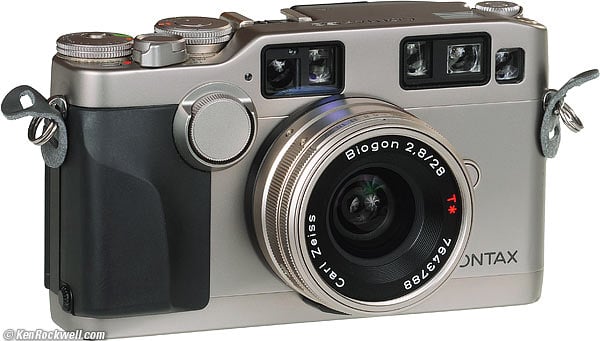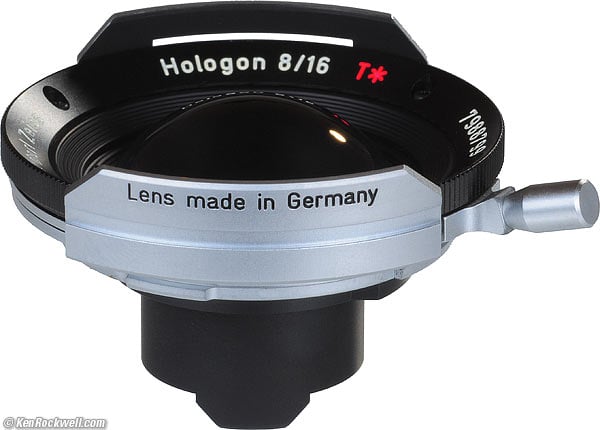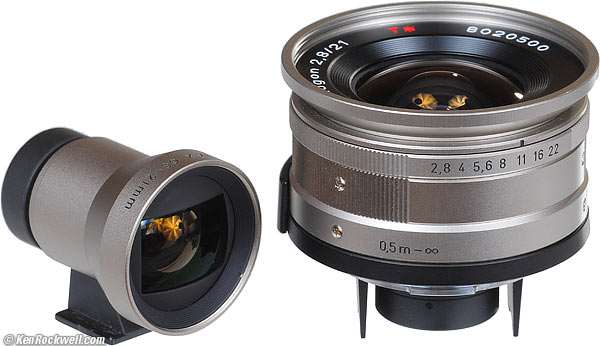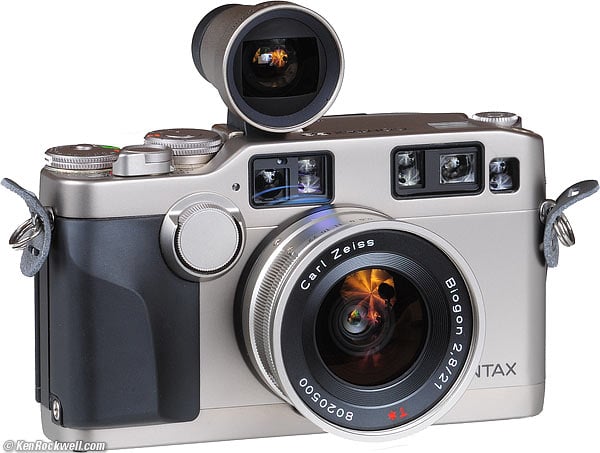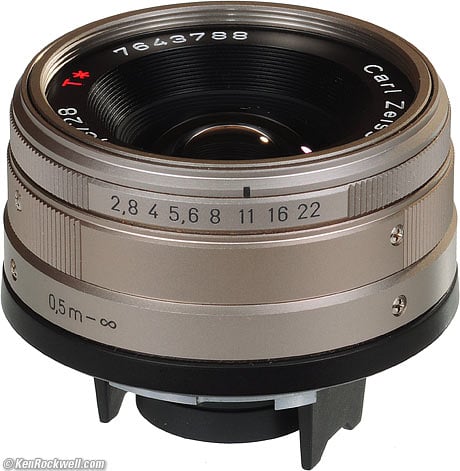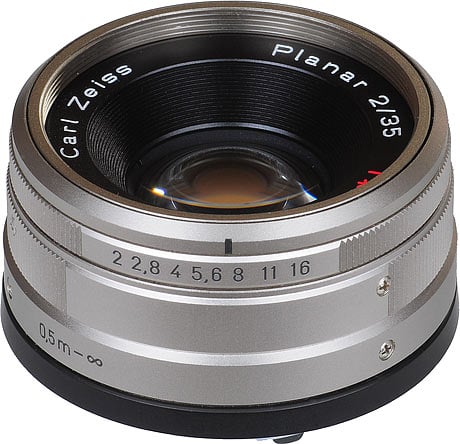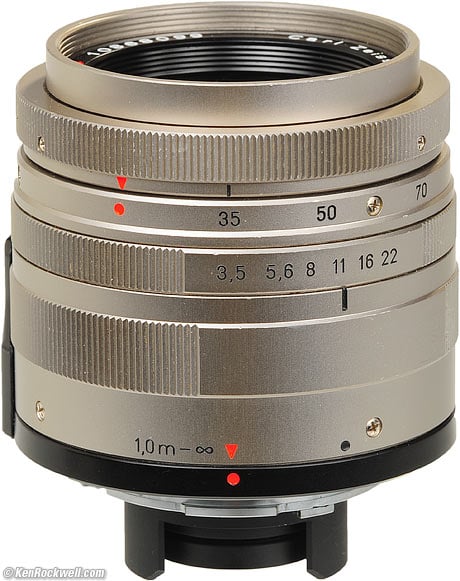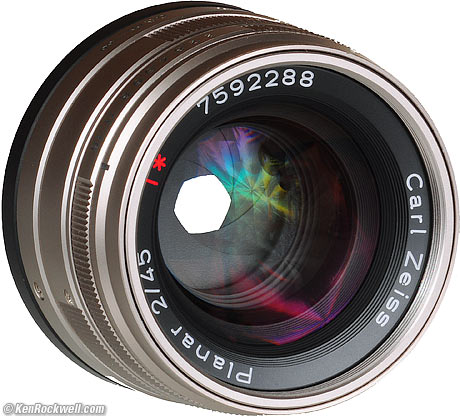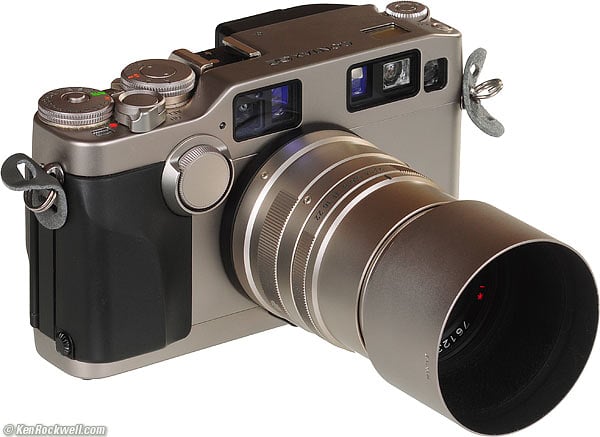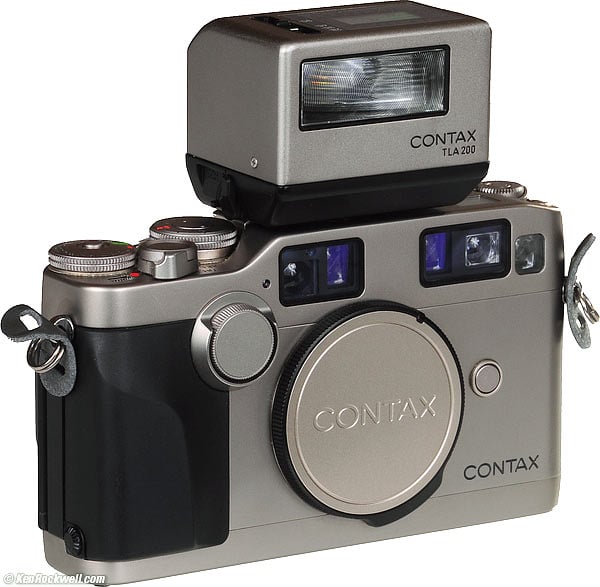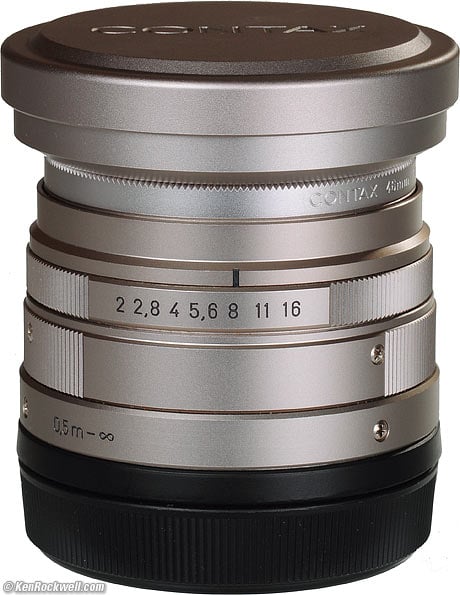Home Donate New Search Gallery Reviews How-To Books Links Workshops About Contact
Contax G System
© 2014 KenRockwell.com. All rights reserved.
Intro Prices Bodies Lenses Flash Accessories Service Recommendations
Contax G2 and Zeiss 28mm f/2.8 in titanium (Contax G mount, 21.4 oz./605g with two CR2 cells and film, but no lens, body only about $400 used. It also comes in black). enlarge. I bought mine at this link directly to them at eBay (see How to Win at eBay).
This free website's biggest source of support is when you use any of these links to approved sources when you get anything, regardless of the country in which you live — but I receive nothing for my efforts if you take a chance and buy elsewhere. I get no government hand-outs and run no pledge drives to support my research, so please always use any of these links to approved sources for the best prices, service and selection whenever you get anything. Thanks for helping me help you! Ken.
March 2014 Contax Reviews LEICA Fuji Better Pictures All Reviews
Contax G2 Full Review 06 November 2009
Contax G2 Users' Guide 06 November 2009
Example Photos: California's Eastern Sierra and Yosemite, October 2008
Contax G Lenses for Leica M 26 February 2009
Leica M vs. Contax G Systems 29 January 2009
Introduction back to top
The Contax G is the world's most advanced 35mm rangefinder camera system.
Once a rich man's camera, what used to cost thousands of 1990s dollars is cheap today. Since rich guys are throwing their money at digital, anyone can buy these exquisite cameras very inexpensively today, and shoot them digitally by having each roll of film scanned when it's developed.
The Contax G system offers seven interchangeable lenses, fast autofocus, autoexposure, TTL light and flash metering, and automatic high-speed film advance and rewind. It was a breakthrough when introduced in the 1990s, and nothing has come close ever since. Leica slept through the whole thing.
The ads of the time touted the great lenses, but so what. What makes the Contax G system so much fun is how fast and easy it shoots. Unlike shooting a manual rangefinder camera like the Nikon SP, which takes me a whole day to get through one roll of film in great pain, the G system works so fast and effortlessly I blow through film quickly.
Since the older cameras take so much out of me with manual fiddling, my one roll of film a day is loaded with nothing but sucky pictures. I can blast though a roll of film on the Contax quickly and have a lot of fun doing it, so the plentiful results from the Contax G system are also much better pictures than I'd make on the more primitive cameras.
Autofocus is via a mechanical screw in the lens mount. The lens has to move out for each shot. Be sure to lock the AF first so the lens extends, and the shot goes off immediately. If you keep the AF locked (or in Continuous mode), the camera is always ready to shoot.
I'll be following this page with new detailed reviews on each piece as I can get my hands on it. I've shot with the G2, 28mm, 45mm 90mm and TLA200 so far.
Pricing, Spring 2009 back to top
These cameras were all bought by rich guys who never used them. When buying used, expect to get them in pretty much unused condition, just like recent Leicas. It's common to get them still in their boxes.
They still aren't free, like Nikon film gear, because the Contax G system is one of the few film cameras still shot today by serious photographers. People still use these cameras.
Very roughly:
$300 - $500 gets you a G1 body and a 45mm f/2 lens.
$600 gets a G2 body only. (only $400 as of 2014)
$700 - 800 gets you a G2 and 45mm lens.
You'll often see a G2 body offered with a complete set of 28mm, 45mm and 90mm lenses and the TLA200 flash. Expect to pay between $800 - $1,300 for the whole load. If the guy still has the boxes and all the extra-cost hoods and filters and caps, you could pay up to $1,500 for the whole system, which is almost nothing compared to a new amateur digital body only.
The 21mm lens is less common; expect to pay $500 - $1,000 for one. Don't forget to get the dedicated finder!
The 35-70mm zoom was never popular, so it's uncommon. Expect to pay about $450 - $700 for one if you find it.
The 16mm lens is offered at around $1,700 - $2,300. Its usually offered at high prices, but I don't know that people are buying them at those high prices.
The 28mm, 45mm and 90mm lenses are very common. You can find them used, still in their boxes and looking new, for about $175 each. They are some of the best lenses ever made for 35mm photography, so I'm astounded at the low prices.
The 35mm f/2 was less popular, as it was rated the softest lens of the bunch and came out after the other lenses. They sell for about $250 ~ $300, used.
Add 25% for black; these prices are for the common silver versions. Contax probably called silver something like "Champagne," "Titanium," "Coin" or "Moonglow." Call them what you want, but there are only two colors: silver or black.
The excellent hoods and 57mm caps for those hoods are expensive, maybe $30 - $40 each, used. You want them for each and every lens you get, because when you get them, the same 57mm slip-on metal cap fits every Contax G lens!
Check Adorama and eBay for pricing today. You can get anything at either place.
Bodies back to top
Intro Prices Bodies Lenses Flash Accessories Service Recommendations
Both bodies share automatically zooming viewfinders, clever AE lock functions, real PC sync terminals, TTL light and flash metering, and have to use the expensive electric Cable Release L instead of a real cable release.
The viewfinders are zoomed mechanically by the position of a lug on each lens mount. The zoom lens simply moves this lug while zooming.
Both cameras show the focused distance in the finder, which is a huge help in confirming that the camera really is focused on the correct subject.
They both run on two small CR2 batteries. Each body is rated for 80 rolls of 24-exposure film per set.
The flange focal distance is specified as 28.95mm ± 0.02mm, per the factory Contax G2 service manual.
Contax G1 (1994-1996) bodies top
The G1 was the first G system body. It shot at up to 2 FPS and cannot use the newer 35mm or 21mm lenses unless modified.
The G1's autofocus is a sloppy active system with an AF illuminator for close distances in the dark.
Shutter speeds are 16 sec ~ 1/2,000 in auto, and 1 sec. ~ 1/2,000 in manual.
Maximum shutter speed with flash is a dreadfully slow 1/100.
Setting the drive mode and manual ISO (the G1 reads DX speeds) requires pushing two buttons and hoping.
Manual focus is via a calibrated dial on the top, with two scales for different lenses. Good luck not forgetting which is which!
AF mode (single or continuous) is locked to the setting of the film advance, which is done by mashing a button.
Manual shutter speeds are on the same dial as the AUTO position, with positions above and below AUTO for exposure compensation, all on the same dial.
Contax rates the G1 at 460g, sans batteries.
Contax G2 top panel (the G2 is also at the top of the page). enlarge.
Contax G2 Full Review 06 November 2009
Contax G2 Users' Guide 06 November 2009
The Contax G2 is a significant step up from the G1 because it adds a second active AF system to the original passive system. In the blink of an eye, the G2 first starts focusing with the active AF system, and then fine-tunes it with the passive AF system. The G2 can use it's new active infrared AF system to focus in the dark at close range. That's all fine and dandy, but the G2 still has the worst AF system of any camera I've ever used. With the 90mm lens, you need to try a few times for each shot and pick the middle distance reading!
The G2 adds the big silver control dial on the front. It usually is used for manual focus, and it also is used for setting other things like manual ISO.
The G2 runs up to 4 FPS. The advantage of this for normal shooting is that each shot is wound so quickly that it just gets out of your way. Press the shutter, you hear a sharp click, and the G2 is done and ready for the next shot. Bravo!
The G2 can use the newest 21mm f/2.8 and 35mm f/2 lenses, while the G1 needs to be modified to take these. Only the G2 can use the 35-70mm zoom.
The G2 has a dedicated wheel to set the film advance mode, compared to a button on the G1.
The G2 has a dedicated AF mode selector for Single or Continuous AF, or manual focus. Inside this selector is a new dedicated AF lock button. Unlike the G1, you may select any AF mode and any advance mode.
The G2's AF is fine most of the time, but it often misses and won't focus. Try again. The G2's AF system isn't good for closeups: I can't get consistent results. When shooting the 90mm lens, I hit the AFL button a few times before each shot to confirm that the same distance reading comes up a couple of times just to be sure.
It's next to impossible to hold the G2 as securely as you'd like vertically, since you block the viewfinder and AF windows.
The finder itself will flare if the sun gets in it; you have to shield it with your hand. Adjust the diopter all you want, the G2 finder never really gets sharp.
The frame counter shows when film is loaded, even with power off. None of the external LCDs are illuminated; good luck in the dark.
The G2 has the same 16 second maximum auto exposure time. The maximum shutter speed increases to 1/6,000 shutter in Auto, and the longest manual speed extends to 4 seconds. The fastest manual speed is 1/4,000, but you can get to 1/6,000 in manual if you bracket by a half stop.
Flash sync is marked, and shows in the finder, as 1/200, but the factory service manual confirms that it's really only 1/180.
The meter's K factor is 1.3, per the service manual. I find that I prefer the results set manually to ISO 64 with ISO 50 Fuji Velvia 50. Both my G2 bodies agree within a tiny fraction of an f/stop, so this seems to be the way the meters are calibrated.
The shutter's vertical transit time is rated at 4.1 ms. For setting TTL off-the-film flash exposure, Contax used Kodak Ektachrome 64 as its reflectance referecne.
Rated maximum current drain is (page C28 of service manual):
Off or idle: 20uA
LCD lit/meter ON: 100mA
Wind: 500mA
Rewind: 400mA
Contax rates the G2 at 560g, sans batteries.
It was reviewed in Popular Photography, September 1997, page 74.
Lenses back to top
Intro Prices Bodies Lenses Flash Accessories Service Recommendations
Overview 16mm 21mm 28mm 35mm 35-70mm 45mm 90mm
The first thing you'll think when unpacking a newly-purchased lens and looking at the aperture ring is that it's screwed up. Not mounted on a camera, you only seem to be able to set about f/8 and smaller. This is normal: when you mount the lens on a camera it works perfectly, but since half the lens mount rotates as part of the bayonet mount, the part of the lens with the aperture index is rotated when the lens isn't on a camera. The aperture index mark moves, but you'll see that the diaphragm works perfectly, even when not on a camera. It's just the index mark which rotates when removed from a body.
Something is wrong with the metallurgy of the lens' mounts. Often I've seen green crud or a green mist which looks like oxidized copper on the lens mount. No big deal, since it wipes right off, but something isn't quite right with the choice of materials.
Bodies |
Close |
Optics |
f/min |
Blades |
Hood |
Filter |
Rear Cap |
Length |
Weight |
|
G1, G2 |
0.3m |
5/3 |
f/8 |
none |
none |
none |
R2 |
11mm |
125g |
|
G2* |
0.5m |
9/7 |
f/22 |
7 |
none |
55mm |
R2 |
35.5mm |
180g |
|
G1, G2 |
0.5m |
7/5 |
f/22 |
6 |
GG-1 |
46mm |
R2 |
30.5mm |
150g |
|
G2* |
0.5m |
7/5 |
f/16 |
7 |
GG-1 |
46mm |
R1 |
31.5mm |
150g |
|
G2 only |
1.0m |
13/8 |
f/22-36 |
7 |
GG-1 |
46mm |
R2 |
71.9~91.9mm |
290g |
|
G1, G2 |
0.5m |
6/4 |
f/16 |
6 |
GG-2 |
46mm |
R1 |
38.5mm |
190g |
|
G1, G2 |
1.0m |
5/4 |
f/22 |
8 |
GG-3 |
46mm |
R1 |
63mm |
190g |
* Also works on G1, if modified as shown by a green sticker in the film chamber.
Index of lens datasheets from Zeiss (hit Service and Support > Download Center > Historical Data Sheets.)
Zeiss 16mm f/8 Hologon. enlarge.
Works on: Contax G1 and Contax G2.
Optics: 5 elements in 3 groups.
Actual (Design) Focal Length: 16.5mm
Diaphragm: None. Fixed at f/8.
Close Focus: 1 foot (0.3m).
Viewing: GF-16mm external shoe-mount finder with level.
Filter Thread: None; center-filter snaps on.
Hood: None.
Size: 2-1/4" diameter by 7/16" long (57 x 11mm).
Weight: 4.4 oz. (125g).
Included: Finder, 2-stop center filter (called "4x gradation filter" by Contax), 57mm GK-54 snap-on front cap, GK-R2 rear cap, "Hologon case" and cloth case.
Made in: Germany.
More Information: Zeiss' technical data.
The 16mm lens is the only part of this system made in Germany. The rest of the Contax G system, and even the finder, filter and case for the 16mm, all comes from Japan.
The 16mm is a weird lens. It must be focused manually. The camera can't measure TTL exposure, so it measures exposure from a peephole on the outside of the body. The camera can't measure TTL flash, so you have to use the old A mode (if you have flash that can cover this angle of view.)
The 16mm only works at a fixed f/8. This means it's too slow to be used in anything but daylight hand-held with chrome film, and can't be stopped down for when you really need depth of field. It may be sharp at f/8, and a 16mm lens has a lot of depth-of-field, but when I really need a sharp image when I also need depth of field, any conventional ultrawide SLR lens is better.
The 16mm comes with a 2-stop clip-on center filter to compensate for its hellacious corner light falloff. This filter has a slight green cast to it, only noticeable if you shoot chrome, which I do.
The 16mm isn't useful for film photography because there's no convenient way to attach other filters. Contax never bothered to make filters in the whacky bayonet mount of the center filter. Contax should have, if it intended anyone to shoot with this lens.
It's useless for B&W photography because there's no way to attach a mandatory yellow or other colored filters required to get correct contrasts. If you've wondered why your clear blue skies are all washed out and without detail or clouds in B&W shots, it's because you forgot to use a filter!
The 16mm is useless for color film photography because there is no easy way to attach color compensating and other filters. I shoot my Velvia through at least an 81A filter all the time, or use other filters as the light requires. Since I can't use filters on the 16mm, I can't get the correct colors, and if I can't get the correct colors, why bother?
I would suggest investigating using gel filters jammed inside the back of the center filter. They would stay protected there.
You never want to use a polarizer with a lens this wide. It sees such a wide angle that nature's polarization effects change over that angle, giving uneven bands of darkness in the sky. That's nature, and why I never use POL filters on ultrawides.
The 16mm lens requires a separate finder slipped into the hot shoe. This finder includes a level for up-down tilt, but sadly, not a circular level, so you still have to guess for left-right Dutching (roll).
The 16mm, like all these lenses, is of course super-sharp edge-to-edge, but has completely zero (less than 0.05%) distortion everywhere. That's irrelevant if you can't get the critical basics, like colors and contrasts, right.
See my 16mm Comparison where I compare this to Nikon and Canon's best.
Comparison of all 21mm rangefinder lenses.
Contax GF-21 finder and Contax G Zeiss Biogon 21mm f/2.8. enlarge.
Zeiss 21mm f/2.8 Biogon on G2, with GF-21 finder. enlarge.
Works on: Contax G2 only. The Contax G1 needs to be modified (look for the green sticker in the film chamber) to use the 21mm f/2.8.
Optics: 9 elements in 7 groups.
Actual (Design) Focal Length: 21.5mm
Diaphragm: Manual, 7 straight blades, stops down to f/22.
Close Focus: 1.65 feet (0.5m).
Viewing: GF-21mm external shoe-mount finder.
Filter Thread: 55mm.
Hood: None.
Size: 2-13/8" diameter by 1-7/16" long (59 x 35.5mm).
Weight: 6.35 oz. (180g).
Included: Finder, 55mm GK-51 snap-on front cap, GK-R2 rear cap, "Biogon case," which is a box.
Made in: Japan.
More Information: Zeiss' technical data and Zeiss' information on the Biogon.
The newer 21mm f/2.8 Biogon only works on the newer G2 body, or an older G1 body that has been modified (look for a green sticker in the film chamber).
Unlike the oddball 16mm, the 21mm is a real, practical lens. Just like the rest of the lenses, you get autofocus and TTL metering for flash and ambient light, screw-in 55mm filters, and it's three stops faster than the 16mm.
The optional billet-metal Contax GK-54 lens cap won't fit because the front of the 21mm is too wide. The Contax GK-54 lens cap will fit very snugly over a Hoya 55mm HMC filter, which has a smaller diameter than the front of the 21mm lens.
The only gotcha is that you have to compose through a separate finder slipped into the hot shoe. The finder is nicer than the finder of the Mamiya 7 43mm lens because its focus is fixed, but the Zeiss finder lacks a level.
The Zeiss 21mm has no visible distortion, although the separate finder sure does.
There are two small amber ghosts near the center of the image if you let the sun hit the lens outside the image area. Be sure to use your hand to shield the lens if the sun is out of the photo, but able to shine on the lens.
The Zeiss 21mm is super sharp, even wide-open at f/2.8.
The Zeiss 21mm is so sharp that you have to pay attention to depth-of-field at f/2.8, even for distant subjects.
Unlike most 21mm SLR lenses that are soft at f/2.8, this Zeiss is ultra sharp. Because this Zeiss is so sharp, areas that are slightly out-of-focus at f/2.8 will be obviously out-of-focus compared to the in-focus areas.
Softer lenses seem to have deeper depths-of-field at f/2.8 because they lack a hard, sharp, in-focus core. With softer lenses, the out of focus area seems more acceptable because there is no significantly sharper in focus area to call it out. Cheaper lenses often are seen as having deeper depths-of-field because their overall softness misleads our eyes to perceive a sloppier, and thus deeper, area as "in-focus."
Because of this, I thought my first test shots of real subjects with the Zeiss 21mm were soft in some areas of the image at f/2.8, even though my tests on the mountain at infinity were sharp edge-to-edge at f/2.8. I first thought I might have a bad sample with some mechanical wobble. NO! What I was seeing was a lack of depth-of-field at f/2.8 because of the extreme sharpness of the narrow in-focus area. When focused at 20 feet (6m), objects that are a few feet (1m) closer or farther away are softer, due to limited depth of field at f/2.8.
I've never used a 21mm lens this sharp or this fast to be able to notice selective focus effects for distant subjects before!
Be sure to stop down if this is going to bother you. This Zeiss 21mm is good enough to show off sloppy focus technique.
Contax G Zeiss 28mm f/2.8 Biogon. enlarge.
Works on: Contax G1 and Contax G2.
Optics: 7 elements in 5 groups.
Actual (Design) Focal Length: 28.4mm
Diaphragm: Manual, 6 straight blades, stops down to f/22.
Close Focus: 1.65 feet (0.5m).
Viewing: Through the camera's usual viewfinder.
Filter Thread: 46mm.
Hood: GG-1 screw-in metal hood, extra cost.
Size: 2-1/4" diameter by 1-1/4" long (56 x 30.5mm).
Weight: 5.3 oz. (150g).
Included: 46mm GK-41 snap-on front cap, GK-R2 rear cap, GCL-1 case.
Made in: Japan.
More Information: Zeiss' technical data.
Price: About $175 used at this link them at eBay.
The 28mm Biogon is a great lens. It's sharp edge-to-edge, even wide open, and has no distortion. All lenses should be this good.
It has moderate light falloff wide-open, which improves a stop or two down. I use this for artistic effect.
It has only so-so bokeh at f/2.8, but so what? Nothing is ever that far out of focus with a 28mm f/2.8 lens anyway.
The corners are still sharp wide open, but they do lose the slightest contrast compared to f/4. This lens is as good as Leica's 28mm f/2.8 ASPH; the two are identical in performance; I've shot tests between them.
Example shot: La Jolla. 28mm lens at f/5.6 on Fuji Velvia 50. original 48 MB scan.
Contax G Zeiss Planar 35mm f/2. enlarge.
Works on: Contax G2 only. The Contax G1 needs to be modified (look for the green sticker in the film chamber) to use the 35mm f/2.
Optics: 7 elements in 5 groups.
Actual (Design) Focal Length: 35.1mm
Diaphragm: Manual, 7 straight blades, stops down to f/16.
Close Focus: 1.65 feet (0.5m).
Viewing: Through the camera's usual viewfinder.
Filter Thread: 46mm.
Hood: GG-1 screw-in metal hood, extra cost.
Size: 2-1/4" diameter by 1-1/4" long (56 x 31.5mm).
Weight: 5.3 oz. (150g), specified. 5.190 oz. (147.15g), measured.
Included: 46mm GK-41 snap-on front cap, GK-R1 rear cap, GCL-1 case.
Made in: Japan.
More Information: Zeiss' technical data.
This is a a very handy lens for shooting anything.
It works great, and the G2 can nail perfect focus with it even at f/2.
It has just a tiny hair of visible barrel distortion. Bokeh is fair to poor at f/2 and neutral at f/4.
It has the least attractive MTF curves (sharpness) of any of these lenses, but it's still an outstanding lens compared to SLR lenses. It's super-sharp even at f/2.
35~70mm f/3.5-5.6 Vario-Sonnar lenses top
Contax G Zeiss Planar 35-70mm f/3.5-5.6. enlarge.
Works on: Contax G2 only. G1 cannot be modified for it.
Optics: 13 elements in 8 groups. Concave front element.
Diaphragm: Manual, 7 straight blades, stops down to f/22-36.
Close Focus: 3.3 feet (1.0m).
Viewing: Through the camera's usual viewfinder, which zooms with the lens!
Filter Thread: 46mm.
Hood: GG-1 screw-in metal hood, extra cost.
Length: 71.9mm (wide) to 91.9mm (tele), overall, specified. Protrusion behind flange: 17.14mm, measured. Extension from flange at wide: 54.06mm, measured.
Weight: 10.2 oz. (290g) specified; 10.405 oz. (295.0g) measured..
Rear Cap: GK-R2.
Pouch Case: GCL-1.
More Information: Zeiss' technical data.
You probably won't see any of these.
They were never popular because they don't focus close enough and have a very slow f/stop. Slow lenses are fine for digital, but for a film camera, an f/5.6 lens is silly.
Ergonimics are poor: it's difficult to feel which ring is the aperture and which ring is the zoom while shooting.
It's easy to mount and unmount, but you must rememebr to zoom it to the 35mm setting. That's why there are red coded dots on the mount and zoom ring.
It focuses with traditional front-group focus, which means that it seems as if focus won't shift if you zoom after the camera shifts the lens to the measured distance, or even during the exposure for zoom-pops.
The zoom ring is the front ring.
Its weird that the front threaded filter ring actually rotates with some friction as you attach or remove filters. In only turns when you turn it. It turns out to be a nice feature, working like a torque limiter to help attach filters just right.
The lower quarter of the finder is blocked at the 35mm setting, and less at the longer settings.
The lens' focal length indication changes as zoomed, but there is no indication of the actural f/stop. The lens gets much slower, from f/3.5 to f/5.6, as its zoomed from 35mm to 70mm.
Contax G Zeiss 45mm f/2 Planar. enlarge.
Works on: Contax G1 and Contax G2.
Optics: 6 elements in 4 groups.
Actual (Design) Focal Length: 46.9mm
Diaphragm: Manual, 6 straight blades, stops down to f/16.
Close Focus: 1.65 feet (0.5m).
Viewing: Through the camera's usual viewfinder.
Filter Thread: 46mm.
Hood: GG-2 screw-in metal hood, extra cost.
Size: 2-1/4" diameter by 1-9/16" long (56 x 38.5mm).
Weight: 6.7 oz. (190g).
Included: 46mm GK-41 snap-on front cap, GK-R1 rear cap, GCL-1 case.
Made in: Japan.
More Information: Zeiss' technical data.
Price: About $150 used at this link to them at eBay.
You'll see zillions of these 45mm lenses because they are the standard for the G series.
The 45mm f/2 is super-sharp, even at f/2.
The 45mm has a tiny bit of barrel distortion. Most people never notice it, even if looking for it.
The 45mm has neutral bokeh at f/2.
The GG-2 metal hood blocks a little bit of the lower right of the viewfinder at infinity, and much more as one focuses more closely. Since the hoods are usually titanium and not black, I sometimes confuse this blockage with part of my subject, instead of recognizing immediately that's it's just the hood blocking my view.
Since all these lenses have totally manual and uncoupled diaphragms, these lenses could have had magnificent 9-blade or 11-blade diaphragms. This 45mm has only has a primitive 6-bladed diaphragm like a discount SLR lens from the 1960s. This means sunstars will only have six points, and out-of-focus highlights might become dopey hexagons.
Bokeh is only fair: not bad, but a little worse than neutral, but so what: this is an ultra-sharp, ultra good lens. I think Popular Photography magazine said something like it was the sharpest 35mm camera lens they'd ever tested, and I wouldn't disagree. The Leica 50mm f/2 rangefinder lens is its competition, not SLR lenses.
Falloff is minimal. The corners don't get much darker even at f/2.
Contax G2, 90mm f/2.8 Sonnar and GG-3 Hood. enlarge.
Works on: Contax G1 and Contax G2.
Optics: 5 elements in 4 groups.
Actual (Design) Focal Length: 90.3mm
Diaphragm: Manual, 8 straight blades, stops down to f/22.
Close Focus: 3.3 feet (1.0m).
Viewing: Through the camera's usual viewfinder.
Filter Thread: 46mm.
Hood: GG-3 screw-in metal hood, extra cost.
Size: 2-1/4" diameter by 2-1/2" long (56 x 63mm).
Weight: 6.7 oz. (190g).
Included: 46mm GK-41 snap-on front cap, GK-R1 rear cap, GCL-2 case.
Made in: Japan.
More Information: Zeiss' technical data.
The 90mm lens is also very popular. It's the only long lens ever made for the G series.
The 90mm lens is super sharp and has very little pincushion distortion. It's at least as sharp as the Leica 90mm f/2.8 Elmarit-M, and the 90mm f/2.5 Summarit-M. Heck, on Velvia under an 8x loupe, it looks as good at f/2.8 as does the Leica 90mm f/2 APO ASPH. This Zeiss Contax lens is as sharp as possible even at f/2.8, right out to the far corners, using test targets at infinity where I can get the whole field in perfect focus. I know; I've shots tests against each other.
The biggest gotcha is that the open-loop (non-TTL) AF system sometimes can miss, and get unfocussed photos if you're not careful. If it's important, check the indicated focus distance, and try focusing a couple of times to be sure the Contax G is really focused on your subject.
Sadly this also could have had a wonderful 9- or 11-bladed manual diaphragm, but settles for a dorky 8-bladed diaphragm instead.
The biggest gotcha with this lens is that the autofocus system of the G cameras isn't precise or repeatable enough to give consistantly perfect focus with the 90mm lens. (it's no problem with any of the others).
Bokeh is only fair.
If you're doing astronomy and set the camera to "Inf." you're perfect, but if you let the camera's auto or manual focus system measure the distance, it's usually off enough to rob sharpness at f/2.8. I take several readings in AF by tapping the AF lock button, and use the reading in the middle of the other readings. This is my biggest beef with the Contax G and the biggest reason I still lug around a Leica: precise, repeatable focus.
Flash back to top
Intro Prices Bodies Lenses Flash Accessories Service Recommendations
The G1 and G2 work with any Contax TLA flash. The two below just happen to be teeny flashes in titanium styled to match the Contax G system.
The G1 and G2 have full TTL flash control. Contax claims perfect fill-flash exposure, but don't believe them. If you want fill-flash, I suggest calculating it manually, since the G2 and G2 just dumbly add exposure, and usually result in gross overexposure with flash used for fill.
The tiny TLA140 flash came out with the G1. It's a tiny thing that stands tall on the camera and provides TTL auto exposure. The flash head is even further away from the lens than the TLA200 below for more resistance to redeye.
The TLA140 weighs only 3.495 oz. (99.05g), complete with battery! Pull out the battery and it weighs only 2.910 oz (82.5g) empty.
Power is rated at only GN 14 meters / 45 feet at ISO 100. I measure GN 35 in feet at ISO 100 (11 in meters), which is as expected. This means enough power for perfect exposure at ISO 50 at 12 feet at f/2.
It runs on one common CR123 battery. I love the CR123s because they are used in all sorts of flashlights and gun sights, so you can get the cheap at places like BatteryJunction.com.
There is no standby mode; if you leave it on while shooting, it stays on forever.
Contax G2 and TLA200. enlarge.
The much improved TLA200 came out with the G2.
The TLA has twice the power (GN 20 meters / 63 feet at ISO 100), and a brilliantly simple 28-90mm zoom head.
The TLA200 weighs 3.995 oz. (113.3g) with two CR2 batteries, or 3.190 oz. (90.4g) empty. With batteries in each, the TLA200 weighs 0.5000 oz. (14.2g) more than the TLA140.
The TLA200 uses two of the same smaller CR2 batteries as the G-series bodies. These small CR2 cells have less power and cost more than the more common CR123 cells used in the TLA140, but it might be nice that the flash and camera take the same batteries.
f you kill the batteries in your body, you can cannibalize them from your TLA200 flash until you get new ones.
Sadly, there is no standby mode for the flash. You cant' leave it on all day as you can with most Nikon flashes. The Contax flash won't go to sleep and wake up when you hit the shutter; it just tays on.
Accessories back to top
Intro Prices Bodies Lenses Flash Accessories Service Recommendations
Contax GK-54 Lens Cap, Contax GG-2 Lens Hood,
Contax 46mm 1A filter, and 45mm f/2 lens. enlarge.
Hoods accessories top
The metal hoods are extra-cost options.
I suggest you get one for each lens because each is designed to take the same expensive optional 57mm slip-on cap.
If you get the hood and optional cap for each lens, you now can use the same cap for every one of the seven lenses made for the Contax. You have no idea how helpful this is in the field in actual shooting; it's something that makes the entire Contax system shine above other camera systems.
∅57GK-54 Lens Caps accessories top
I kid you not: Contax sucked money out of rich guys not only by selling them lens hoods and designer filters à la carte, Contax even sold separate metal designer caps to replace the regular hybrid plastic and metal ones with which the lenses came!
These are nice billet-metal caps with engraved markings and finished in faux titanium. They have inside diameters of 57mm to slip over the hoods, and have inner felt linings.
They slip over the hoods very nicely, and seal just right. They don't seem likely to fall off.
The GK-54 metal cap was used to slipped over the front of any of the GG-1, GG-2 and GG-3 hoods, when the hood was left screwed into a lens.
Not only do they fit over the hoods of the 28mm, 35mm, 35~70mm, 45mm and 90mm lenses, they also fit directly over the front of the 16mm and 21mm lenses, which have no hoods. To fit on the 21mm you need to put the cap over a normal (Hoya) 55mm filter, which is the correct diameter for the cap.
Buy the hoods, and now the same cap fits on every lens in the entire system. This sold me; I won't shoot without the hoods and these caps since it makes lens changing so easy in the field.
Filters accessories top
Contax made a limited range of filters complete with faux titanium finishes to match the system.
This is cute, and the insides are properly black, but I see no fashion faux-pas using standard black-ring filters. The cameras and lenses have black grips and bases, so using a black filter actually keeps in time with the rhythm between dark and light. Using faux-titanium filters would turn the lens into an uncomfortable long expanse of faux titanium with no break.
Marking is fun. Since Contax made no polarizer in 46mm, instead of just being honest and saying "we don't make one," the marketing wizards used FUD to make themselves look even more exclusive for this omission. The pitch was that "Zeiss and Contax only do things exactly," and that since you can't see through the lens to adjust the polarizer, they claimed that polarizers aren't exact enough for Zeiss or Contax for use on a rangefinder camera.
An intelligent person would interpret that as Contax saying that they prefer a photo which is exactly wrong to one that is mostly right, or that rangefinder cameras aren't really a good idea for serious photography, which is why they all went obsolete back in the 1960s when SLRs came out.
Not to worry: I use polarizers all the time on rangefinders. Simply hold the filter over the viewfinder, rotate to taste, and put it over the lens in the same orientation (use the lettering on the outside of the filter ring). UNlike most rangefinders, the G series are superb in that 1.) their TTL meters give the correct exposure through the filter, and 2.) that you can use any old linear polarizer; you don't need the more expensive circular polarizers needed for modern SLR cameras.
GD-1 date back accessories top
This is the date back for the G1. All it does is mark the date.
The GD-1 is a date, not data, back.
GD-2 Data Back accessories top
The GD-2 data back is for the G2. It also records shooting data, but since the apertures don't couple to the camera, if has to guess at the aperture setting. It will guess T/stops if you use filters.
You can imprint the data between frames, or have it imprint the data for all shots in the roll on two dedicated frames instead.
Cable Switch L accessories top
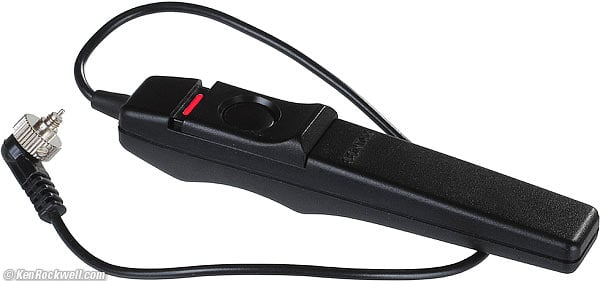
Contax Cable Switch L.
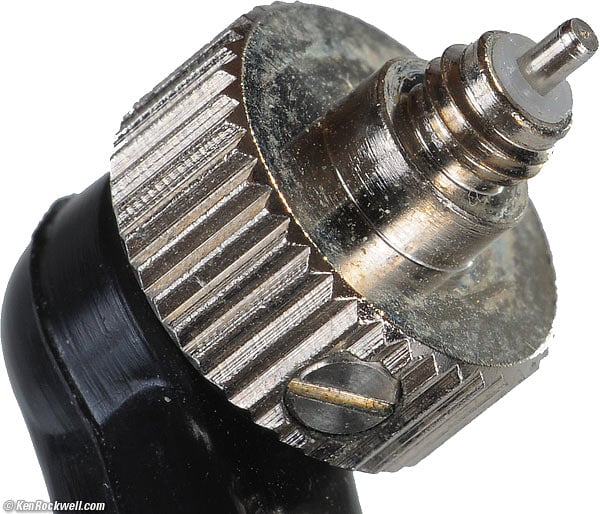
Tip, greatly magnified.
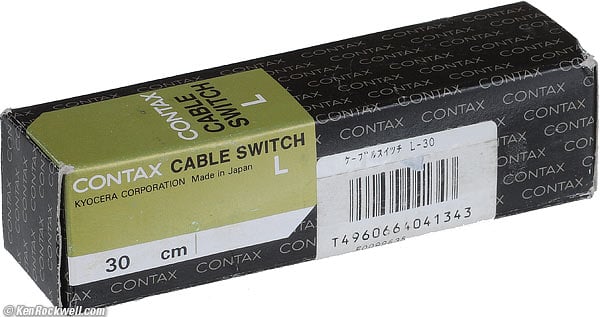
Box. Note 30 cm marking.
This is the dedicated release cord.
Watch out: I first tried to stick it in the hole marked "R." All that did was rewind my film. Oops!
The release goes in the unmarked silver hole. Once you thread it in, it's nice because it swivels! I'm unsure if you can fire off accidental shots as you jam it in the correct hole.
There is no halfway position to lock focus or exposure. The release is either ignoring you, or shooting pictures.
Just to be difficult, this cord comes in four versions. It comes in 30cm, 100cm, 300cm and 1000cm (1 foot, 3 feet, 10 feet and 30 feet) lengths. God bless you if you get the one you want.
Power Options accessories top
Both bodies take the GP-1 inside their battery chambers, which in turn lets you connect the P-8 battery holder for 4-AA and keep it in your pocket in the cold.
Oddly, 4-AA alkalines are only rated only 25 rolls of 24 exposure!
GA-1 lens adapter accessories top
This mechanical adapter lets you use Contax SLR lens on the G bodies. God only knows why you'd want to bother.
You can set the adapter to trigger the correct finder display for 28, 35, 50, 60 and 85mm lenses!
You get no autofocus. You have to read the distance from the electronic AF system and set that one the lens. Good luck!
You get TTL metering.
Cases accessories top
For the G1
The G1 takes the GC-11 case. It has two parts: the GC-110 inner body case, and GC-111 front outer lens portion. For use with the 90mm lens, buy the extra GC-112 front portion.
For the G2
The G2 takes the GC-21 case, or the GC-22 case if using the GD-2 data back.
If using the 90mm lens, also buy the GC-212 long front cover.
Service back to top
Intro Prices Bodies Lenses Flash Accessories Service Recommendations
Service people have been trying to scare me away from the Contax G2 and 645 for a while, warning that they are extremely complex internally and there are only limited parts with which to fix them.
In 2009, it took me half a second to confirm that ToCAD still cheerfully repairs all G2 and 645 cameras and lenses, and estimates that they have enough parts to last them through 2015.
They also estimated that they only had enough parts for the G1 to cover them through 2006, but they're still fixing those, too, as of 2009.
These cameras are repaired in the USA. The made-in-Japan Zeiss Contax lenses are still repaired at the Kyrocera factory at which they were made.
No problem. If my G2 or 645 dies after 2015 and if I can't get it repaired, I simply by another body for a few hundred dollars — about what I paid for my last CF card — and I'm good to go.
As of 2015, Nippon Photo Clinic services them.
Recommendations back to top
Intro Prices Bodies Lenses Flash Accessories Service Recommendations
Want the smallest 35mm camera system with interchangeable lenses and modern speed, precision and convenience? This system left Leica in the dust ten years ago, and you can get them cheap today.
The easy lens changing and automation makes it fast and fun to shoot, and since you are always using filters with film, the TTL metering makes it easy.
Sure, you could pay a lot more for a modern or old Leica or Nikon SP rangefinder system, but you'll miss a lot of photos twiddling with manual focus and manual film winding, and miss even more with manual or off-camera metering.
You can spend even less money and get even more advanced metering and automation in almost any old Nikon SLR like the N90s, F4 or FA, or pay more for today's incomparable F6, but any of them are much bigger. You could get a plastic N80 or N75 for lighter weight, but the outer dimensions are still a bit bigger. All these Nikons have the modern Matrix meter, which is 30 years ahead of the center-weighted meter of this Contax and the head-buried-in-yesterday's-glory LEICAs.
If you want ultra quality on film, skip 35mm entirely and step right up to medium format with the Mamiya 7, which isn't much bigger or heavier, and has about four times the area resolution.
PLUG
I support my growing family through this website.
If you find this as helpful as a book you might have had to buy or a workshop you may have had to take, feel free to help me continue helping everyone.
If you've gotten your gear through one of my links or helped otherwise, you're family. It's great people like you who allow me to keep adding to this site full-time. Thanks!
If you haven't helped yet, please do, and consider helping me with a gift of $5.00.
The biggest help is when you use any of these links when you get anything. It costs you nothing, and is this site's, and thus my family's, biggest source of support. These places always have the best prices and service, which is why I've used them since before this website existed. I recommend them all personally.
Thanks for reading!
Ken
Home Donate New Search Gallery How-To Books Links Workshops About Contact
